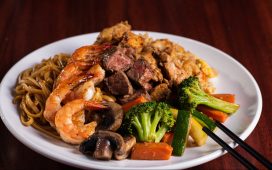Table Of Contents
For some, cooking meat to perfection can be intimidating. After all, it’s expensive, and if you ruin it, you just wasted a whole lot of time and money.
Never fear!
There’s a perfect way to cook every cut, and it’s easier than you think to get it right.
Here’s a quick guide to cooking methods and how to ensure each meaty slice reaches its full roasting, broiling, charring, grilling, or baking potential.
Ways to Cook Meat
With so many options, how do you know what’s what? I mean, what’s the difference between baking, broiling, and roasting? Why is grilling better sometimes but not others? Which way seals in the most flavor?
Is your head about to explode? Here’s a quick rundown.
Grilling
This technique uses, you guessed it, a grill. It can be done over low, medium, or high heat and is typically done outside. You can do steaks, hot dogs, or a whole roast on the grill. While charcoal is a bit trickier than gas, it leads to deeper, more intense flavor.
Hint: most grill masters prefer charcoal, so if you want to look like a pro, figure out how to do it this way!
Braising
This lower temperature method of cooking seals in the moisture and tenderizes tough cuts. Season and sear the cut in a skillet then transfer it to a pot with a tiny amount of liquid in the bottom and finish it out on the stove.
You can add tomatoes, potatoes, carrots, or anything else you want to the pot for added flavor and color.
Hint: replace the pot on the stove with a slow cooker for a truly hands-free braising experience.
Stewing
This also uses slow, moist heat, but instead of doing the entire large piece of meat at once, cut into smaller pieces first, and don’t sear it in a skillet first.
Hint: it requires more liquid than braising, so it’s an excellent choice for soupier meals.
Roasting
This technique involves dry heat at high temperatures. It gives your meat a crispy exterior, like in beef burnt ends. A short burst of high heat is perfect for smaller cuts while larger pieces may require most of the cooking at a low temperature with a final sear in a hot oven at the end.
Hint: meat cooks quickly at high temperatures, so you can’t break down any connective tissues in tough meats using this method.
Broiling
Think of this as upside down grilling. Instead of placing the meat above the source of heat, place it directly below. Broiling works the same way. It essentially grills the top of your meat.
Hint: brush your meat with oil to prevent it from drying out using this method.
Stir-frying
This is a quick method of cooking thin strips of meat. It’s easy because all you have to do is throw all of your ingredients in the same pan and fry them up. Peppers, onions, carrots, and anything else you want to add for flavor is welcome.
Hint: this is an easy dish to customize and make your own because of how quick and easy it is.
Smoking
This type of cooking uses a grill or a smoker. At low temperatures, it pulls the smoke across the meat, cooking it very slowly. It often takes eight hours or more to smoke a cut of meat.
This is common among barbeque cuts like ribs, brisket, or pork. You can even smoke your Thanksgiving turkey or your Christmas ham.
Hint: to enhance the flavor, add your favorite wood to the grill like maple, cherry, mesquite, or hickory.
How to Cook Your Meat
There are plenty of interesting facts about meat floating around out there. They may help you with your cooking, or they may just be fun to read. However, now that you know your options, here’s how to know which method of cooking to choose.
Tender beef, pork, or game
Tender meats like tenderloins don’t have as much connective tissue to break down, so you don’t have to choose a slow method unless you want to. You can quickly braise or sear them to perfection and they’ll still be as tender as ever.
Tough cuts
Ribs and briskets should be cooked slowly, which is why smoking meats is so popular among barbeque restaurants. Cooking slowly over low heat adds moisture and breaks down the proteins in the meat.
Stewing or braising are also excellent choices for slow cooking.
Chicken and duck
If you’re buying your chicken at the grocery store, it’s likely young and tender already. Roasting a whole chicken in the oven allows the fat from the skin to add flavor to the meat.
Legs and thighs are fattier and work really well on the grill, because they’re hard to overcook.
Chicken breasts can be dry, so you should lock in the juice by cooking them with the skin on. You can also brine them to add moisture.
Duck is a very fatty meat, so you can sear the cut to caramelize the skin and infuse the skin with moisture.
Turkey
Turkey is lean, so it can dry out easily. Cooking it slowly and steadily to avoid overcooking is ideal, if you have the time. It can seal in the moisture and give it a deep and delicious roasted flavor.
Whole fish
Fish can be lean or oily, but you can prepare them using almost any cooking method. It depends on your desired result. Grilling, steaming, or pan frying are the most popular methods for small fish. Large fish do well with roasting, broiling, or baking.
Fish steaks
Thick fish steaks and oily fillets do well with roasting or baking. You can wrap them in parchment paper and toss them in the oven to steam, but avoid turning often so they don’t fall apart.
More Information
If you still have questions about how to cook your meat, MeatScience.org is a great source of information for cooking methods and different types of meat.
The best thing you can do is experiment. Only you know how you like your meat cooked, so give some things a try and you’re likely to find your favorite new recipe.







1 Comment